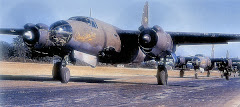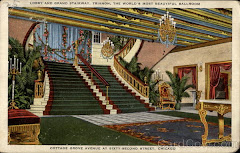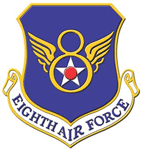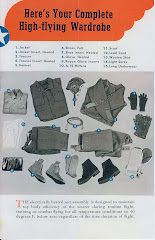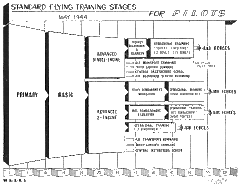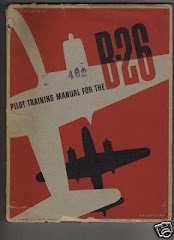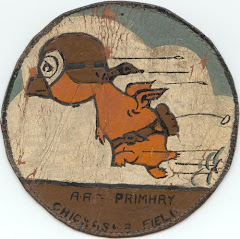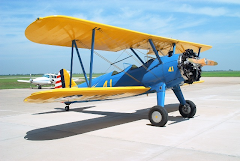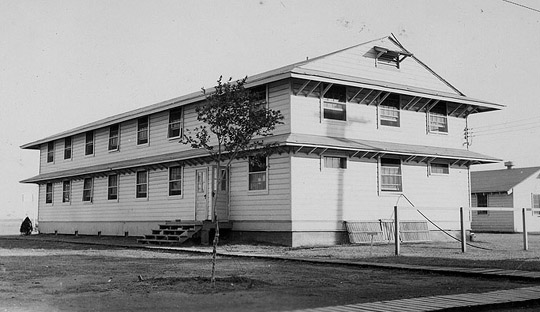After a week’s leave and a Greyhound bus ride to the panhandle of Texas about 40 miles northeast of Amarillo, where the Pampa Army Airfield was located, we started Advanced Flight School. It was February 1943 and the weather was often cold and sometimes stormy. The skies were generally clear with big cumulus clouds and fierce air currents. We appreciated the special uniforms, boots and gloves to help keep us warm when we were in the air, where it was many degrees colder than the Panhandle.
Although the airfield was similar to the one at Enid in terms of runways, hangers, control tower and water tower, the living accommodations were nothing like the nice two story barracks we’d had at Enid. We were now living in what might be termed a tar paper shack. Luckily we were there to learn to fly, and as far as accommodations we were all in the same boat, as always.
Now we were learning how to maneuver twin engine planes. They were faster, more complex, less forgiving and definitely more challenging. We had to learn how to handle the new power and speed. All the courses we’d learned in basic were geared for these bigger, more powerful planes. Meteorology and Navigation were delved into deeper here. And, we finally learned how to shoot those guns we’d been marching with. There was a skeet shooting range on the base and some of the guys had to spend a lot more time there than I did because of my pheasant hunting days. We were still doing calisthenics, obstacle courses and weightlifting. I had always been strong from my farming days but I was now feeling like quite the athlete.
We had about 12 hours of flying with the instructor before we did our daytime solo and around 25 for our nighttime solo. We practiced takeoffs and landings over and over, probably doing 80 or 90 during our training, most of them at night. Most flying was now done by instruments. There were six students per instructor in our class. Our instructor got our group checked out in an AT-9. Most of the instructors thought the AT-9s were too hot for students and kept them flying the AT-17s but we loved the 9s and had a ball with them. This is when we learned to love to fly.
Sunday, August 9, 2009
Saturday, July 18, 2009
Chapter 13 Basic Flight Training -2 Enid, Oklahoma
Officially, we were doing our basic pilot training at the US Army Air Force Flying School in Enid, Oklahoma. We were Aviation Cadets. We were still on a fast and tight training schedule at Basic because the war needed pilots. Civilian manufacturers were building planes as fast as they could and the Army Air Force was training the men to fly them. Up until December ’42, when voluntary enlistments were terminated, the Army Air Force had been a volunteer organization. Then, if you were drafted into the Army, you could apply for enlistment in the Air Force but the Air Force recruiters skimmed “the best of the best” men from the Army for their program – and they told us about the rigorous selection because it meant we were surrounded by men of caliber. They were building our confidence, attitude and pride.
Things were a little less stressful at Enid because we knew we’d made the cut. Almost half the guys that started were gone, but we hadn’t washed out. Physical training was still a big part of our daily regimen. We marched to classes and infantry drill singing the Air Corps song, “Off we go into the wild blue yonder…”. We became part of a coordinated team.
Flight training in basic involved a lot of navigation, instrument flying, night flying, cross country flying, and formation flying. Learning how to do all these maneuvers involved both actual flight experience and learning in flight simulators called Link Trainers. Link Trainers were used mostly for learning instrument flying.
Formation flying was a challenge for most of us. You had to tuck your wing right behind the instructor’s wing and stay in exactly that position. It was easy if he was flying level and going straight ahead. It was still pretty easy to stay in position through speed increases and decreases. Soon there were turns, then climbing turns and even loops. We practiced over and over, the instructor constantly stressing the importance of formation flying. It seemed like that’s all we would be doing. Later, when we were in combat we’d be thankful for those stringent exercises.
Night flying was another challenge that required learning to go over and over the flight details from weather to headings to checkpoints. Every morning went to ground school learning how to navigate, studying plane engines and systems, practicing Morse Code. We learned radio procedures and theory of flight.
Finally, after weeks of practice we got to the end of Basic Training and were waiting our assignments to the next phase of training. Assignments were finally posted. I would be going to multi-engine advanced flight training in Pampa, Texas! Our graduation was celebrated at a Stag Dinner held in the cadet mess hall, but we didn’t eat out of our mess kits that night.
Things were a little less stressful at Enid because we knew we’d made the cut. Almost half the guys that started were gone, but we hadn’t washed out. Physical training was still a big part of our daily regimen. We marched to classes and infantry drill singing the Air Corps song, “Off we go into the wild blue yonder…”. We became part of a coordinated team.
Flight training in basic involved a lot of navigation, instrument flying, night flying, cross country flying, and formation flying. Learning how to do all these maneuvers involved both actual flight experience and learning in flight simulators called Link Trainers. Link Trainers were used mostly for learning instrument flying.
Formation flying was a challenge for most of us. You had to tuck your wing right behind the instructor’s wing and stay in exactly that position. It was easy if he was flying level and going straight ahead. It was still pretty easy to stay in position through speed increases and decreases. Soon there were turns, then climbing turns and even loops. We practiced over and over, the instructor constantly stressing the importance of formation flying. It seemed like that’s all we would be doing. Later, when we were in combat we’d be thankful for those stringent exercises.
Night flying was another challenge that required learning to go over and over the flight details from weather to headings to checkpoints. Every morning went to ground school learning how to navigate, studying plane engines and systems, practicing Morse Code. We learned radio procedures and theory of flight.
Finally, after weeks of practice we got to the end of Basic Training and were waiting our assignments to the next phase of training. Assignments were finally posted. I would be going to multi-engine advanced flight training in Pampa, Texas! Our graduation was celebrated at a Stag Dinner held in the cadet mess hall, but we didn’t eat out of our mess kits that night.
Thursday, May 14, 2009
Chapter 12 Accessories Instill Pride
Now that we were in basic training at Enid we could relax a little. We were told that over 40% of our class had "washed out," but we'd made the grade. The Army was going to instill us with pride and convince us we were the best they had. They heaped praise on us for making it to this stage of training, calling us "the cream of the crop" and telling us we had the right to be proud. We kept marching to classes in cadence singing inspirational songs. We were told we were going to be the "best trained air-force in the world." The silver wings helped a lot.
 |
| Coveted Silver Wings of Cadets |
 |
| Cadet Insignia on Patch |
Thursday, April 23, 2009
Chapter 12 The Magnificent Flying Machines
At Enid we got about 50 hours of training in the TB25 also known as the AT-24. No more open cockpit, 2 seater planes for us, this was an exciting plane! They ones we had were 2 engine, dual controls that could hold a 3-5 man crew. The nose of the plane was what they called the "greenhouse" made of plexi-glass to give the bombardiers as good a view of their target as possible. Of course we didn't have any crew we were still learning to fly.
Thursday, April 2, 2009
Saturday, March 21, 2009
Chapter 12 Basic Flight Training, Enid OK
Enid Oklahoma was about 100 miles north of Chickasha. After a couple days leave we were loaded on a bus that traveled straight north on U.S. Highway 81 to Enid. We arrived about a year after it was first constructed. The barracks were two story frame buildings that looked like very large houses. There was the usual parade ground and of course hangers and runways. Built as a temporary base, the main feature was a huge water tower roughly in the center of the base.
One of the first things they did at Enid was issue rifles. We had to clean and assemble them and be able to take them apart and put them back together. For an old pheasant hunter like me it was second nature but many of the guys had never seen a gun before. Surprisingly, we weren’t taught to shoot the rifles, we just had to know how to assemble them and carry them in marches and parades.
They were very strict about us keeping orderly quarters. The term “white glove inspections” came from military inspections. The officer would put on a white glove and run his finger across every surface in the barracks. If any dust accumulated on the glove or discolored it, demerits were handed out. When you accumulated demerits over the maximum allowed you had to “walk them off” on the parade grounds on Saturdays. It was usually one hour of walking for each demerit over the limit.
Day to day classes at Enid continued, much like at the previous two bases, with the usual physical fitness drills, obstacle course, close order drills, marches, and lecture classes on military indoctrination, common courtesy, math, weather, navigation and specialty classes on airplane instruments, airplane recognition and airplane mechanics.
After about 70 hours of flying and daily classroom training, we were assigned to the TB25 airplane, also known as the AT-24. They were dual control, 2 engine bomber planes that flew with a 5 man crew. They had a top speed of over 300 miles per hour.
By the end of Basic they would decide who would be fighter pilots and who would be bomber pilots. Of course we all wanted to be fighter pilots, that’s why we practiced our aerial acrobatics every chance we got. They determined the assignments by instructor recommendations, tests they gave us, performance in class and what they needed most at the time.
One of the first things they did at Enid was issue rifles. We had to clean and assemble them and be able to take them apart and put them back together. For an old pheasant hunter like me it was second nature but many of the guys had never seen a gun before. Surprisingly, we weren’t taught to shoot the rifles, we just had to know how to assemble them and carry them in marches and parades.
They were very strict about us keeping orderly quarters. The term “white glove inspections” came from military inspections. The officer would put on a white glove and run his finger across every surface in the barracks. If any dust accumulated on the glove or discolored it, demerits were handed out. When you accumulated demerits over the maximum allowed you had to “walk them off” on the parade grounds on Saturdays. It was usually one hour of walking for each demerit over the limit.
Day to day classes at Enid continued, much like at the previous two bases, with the usual physical fitness drills, obstacle course, close order drills, marches, and lecture classes on military indoctrination, common courtesy, math, weather, navigation and specialty classes on airplane instruments, airplane recognition and airplane mechanics.
After about 70 hours of flying and daily classroom training, we were assigned to the TB25 airplane, also known as the AT-24. They were dual control, 2 engine bomber planes that flew with a 5 man crew. They had a top speed of over 300 miles per hour.
By the end of Basic they would decide who would be fighter pilots and who would be bomber pilots. Of course we all wanted to be fighter pilots, that’s why we practiced our aerial acrobatics every chance we got. They determined the assignments by instructor recommendations, tests they gave us, performance in class and what they needed most at the time.
Sunday, February 22, 2009
Chapter 11 Primary Flight Training Continues
In Chickasha we received our training at a civilian owned and operated flight school, The Wilson and Bonfils Flight School. Classes were also taught and flight checks given by a military staff.
Close order drill, calisthenics and obstacle courses continued in Primary school as did the classes in airplane recognition, meteorology, and ground school. The Army method of learning was memorization. We were expected to be able to memorize everything. It was a good discipline and in times of stress, it stood you well.
Our accommodations at W&B were known as the “Country Club” because everything was civilian in the mess hall from food to dishes and in the barracks from the beds and mattresses to the linens. Everything outside the mess hall and the barracks was strictly military.
In the afternoons our flight training continued. I was lucky to have done my solo a little earlier than most of the cadets. I was able to spend more time shooting landings and practicing the basics and acrobatics. When he rode with me after my solo, the instructor taught me forced landings. He’d cut the throttle and force me to find a place to land. Luckily there were a lot of fields in Oklahoma. Just about the time the wheels were going to touch the ground, he would take over and climb to a safe altitude, then hand it back and tell me to practice something else. Soon he’d cut the throttle again and I’d be forced to land again. Later, I spent a lot of time practicing these forced landings myself. Little did I know all that practice would eventually save my life and the life of 6 other crew members somewhere over France.
There were flight checks at the end of each phase of flying lessons. There was nothing the “checkers” liked better than washing out the unfit pilots. If you didn’t make the grade, or even if they just didn’t like you, you could be weeded out. You got two chances. If you didn’t pass the first test you got one more by a different checker. He knew it was your second of course, and if you failed his check you were reassigned to navigator or bombardier school. Luckily, I never had to take a second flight check.
Winter in Oklahoma was pretty cold and many days we woke to snow deep enough to entertain us guys by making snowmen or blow off some steam by having a few snowball fights. Mostly we had 10 short weeks to learn how to fly and between that and military drills and classes there wasn’t a lot of free time.
When our ten weeks was up Class 43E had a Graduation ceremony. Those that made it through were sent on to Basic Flight Training. Our class was going to Enid Army Flying School in Enid, Oklahoma
Close order drill, calisthenics and obstacle courses continued in Primary school as did the classes in airplane recognition, meteorology, and ground school. The Army method of learning was memorization. We were expected to be able to memorize everything. It was a good discipline and in times of stress, it stood you well.
Our accommodations at W&B were known as the “Country Club” because everything was civilian in the mess hall from food to dishes and in the barracks from the beds and mattresses to the linens. Everything outside the mess hall and the barracks was strictly military.
In the afternoons our flight training continued. I was lucky to have done my solo a little earlier than most of the cadets. I was able to spend more time shooting landings and practicing the basics and acrobatics. When he rode with me after my solo, the instructor taught me forced landings. He’d cut the throttle and force me to find a place to land. Luckily there were a lot of fields in Oklahoma. Just about the time the wheels were going to touch the ground, he would take over and climb to a safe altitude, then hand it back and tell me to practice something else. Soon he’d cut the throttle again and I’d be forced to land again. Later, I spent a lot of time practicing these forced landings myself. Little did I know all that practice would eventually save my life and the life of 6 other crew members somewhere over France.
There were flight checks at the end of each phase of flying lessons. There was nothing the “checkers” liked better than washing out the unfit pilots. If you didn’t make the grade, or even if they just didn’t like you, you could be weeded out. You got two chances. If you didn’t pass the first test you got one more by a different checker. He knew it was your second of course, and if you failed his check you were reassigned to navigator or bombardier school. Luckily, I never had to take a second flight check.
Winter in Oklahoma was pretty cold and many days we woke to snow deep enough to entertain us guys by making snowmen or blow off some steam by having a few snowball fights. Mostly we had 10 short weeks to learn how to fly and between that and military drills and classes there wasn’t a lot of free time.
When our ten weeks was up Class 43E had a Graduation ceremony. Those that made it through were sent on to Basic Flight Training. Our class was going to Enid Army Flying School in Enid, Oklahoma
Tuesday, January 13, 2009
Chapter 10 Off We Go Into the Wild Blue Yonder!
Beginning to Fly – Meet the Fairchild PT 19
We learned to fly in the Fairchild PT 19 and the BC-1. The rugged little PT 19 was a one engine trainer aircraft. It had two open cockpits, the instructor sat behind you. It had plywood wings, fixed landing gear and flew at the phenomenal speed of about 130 mph! In truth, this was fairly slow for a light weight plane. The PT was also pretty stable, two positive factors for would-be pilots. Because of the open cockpit, the wind and colder temperatures the higher you flew, we were fitted out in two piece flying suits with fur collars, lined gloves, warm felt boots and leather helmets with goggles. (When we weren’t wearing the goggles, they were to be worn around our necks. Once we had completed our first solo flight we could wear them on our helmet.) Later, when we were overseas, our flying suits would have heated pants liners, heated jacket liners and heated gloves but for now we were so excited we didn’t notice the cold.
In addition to actual flying time every afternoon we were attending ground school and continuing our physical training during the first half of the day. We were also being thoroughly taught “military indoctrination” (the name of the course).
I was lucky to be assigned to a great instructor who stuck with me even though I was getting air sick just about every time I went up. I still remember my instructor’s name was William Dwyer. We were learning all the fundamentals: take offs, landings, forced landings, “s turns,” stalls, spins, loops etc. After about 24 hours of training with the instructor he told me to take my first “solo” flight which consisted of 3 or 4 take offs and landings. I was one of the first cadets in the class to do his solo and was quite proud to go back to the barracks wearing my goggles on my helmet.
The worst part of this training was when we started doing acrobatics. After training with the instructor for several days I would go up by myself and do several snap rolls, get sick, then go back and do it all over again. It took about forty hours of flying time before I got over the airsickness but it never bothered me again after that.
We learned to fly in the Fairchild PT 19 and the BC-1. The rugged little PT 19 was a one engine trainer aircraft. It had two open cockpits, the instructor sat behind you. It had plywood wings, fixed landing gear and flew at the phenomenal speed of about 130 mph! In truth, this was fairly slow for a light weight plane. The PT was also pretty stable, two positive factors for would-be pilots. Because of the open cockpit, the wind and colder temperatures the higher you flew, we were fitted out in two piece flying suits with fur collars, lined gloves, warm felt boots and leather helmets with goggles. (When we weren’t wearing the goggles, they were to be worn around our necks. Once we had completed our first solo flight we could wear them on our helmet.) Later, when we were overseas, our flying suits would have heated pants liners, heated jacket liners and heated gloves but for now we were so excited we didn’t notice the cold.
In addition to actual flying time every afternoon we were attending ground school and continuing our physical training during the first half of the day. We were also being thoroughly taught “military indoctrination” (the name of the course).
I was lucky to be assigned to a great instructor who stuck with me even though I was getting air sick just about every time I went up. I still remember my instructor’s name was William Dwyer. We were learning all the fundamentals: take offs, landings, forced landings, “s turns,” stalls, spins, loops etc. After about 24 hours of training with the instructor he told me to take my first “solo” flight which consisted of 3 or 4 take offs and landings. I was one of the first cadets in the class to do his solo and was quite proud to go back to the barracks wearing my goggles on my helmet.
The worst part of this training was when we started doing acrobatics. After training with the instructor for several days I would go up by myself and do several snap rolls, get sick, then go back and do it all over again. It took about forty hours of flying time before I got over the airsickness but it never bothered me again after that.
Labels:
Chapter 10 Fairchild PT 19,
flying school,
pilot's story,
solo
Monday, January 5, 2009
Chapter 9 Hallaleujah! Cadet School
I was first sent to an Army Air Corps base for recruits near Waco, TX. It was under construction at the time and after a few days, in March of 1942, we were sent to Kelly Field in San Antonio, TX for basic training. This lasted about six weeks. We did close order drill, took a lot of tests, did hours and hours of physical training and learned the usual Army routines. Weekends were for marching or parading.
We were billeted in tents while the base was under construction. They put us in alphabetical order and I became longtime friends with several men in my tent who had the same first letter in their last names. In addition to the tents, the base consisted of about 40 or 50 buildings that had recently been constructed to house classrooms, supplies, administration offices, residences for instructors, maintenance personnel, commissioned officers and noncoms and the Army Air Force Navigation School which had been transferred to Kelly from Barksdale Field.
Kelly was the training center for advanced aviation training of bomber pilots and crews. The demand for bomber crews had been escalating since Pearl Harbor and Kelly was a beehive of incoming cadets who would be trained to be navigators, bomber pilots or bombadiers as well as construction crews building almost as fast as new recruits arrived. But we weren’t ready for bomber school yet and as soon as we were through with basic training (April ’42) we were transferred out of Kelly. (A few months later, in July of ’42 it was renamed the San Antonio Aviation Cadet Center.)
Next we were sent to Chickasha, Oklahoma for primary flight training at the Wilson and Bonfils Flying School. Cadets had begun training to become U.S. Army Air Corps pilots there in October of 1941. More than eight thousand recruits trained to be aviators there during the four years that the school trained pilots for the Army. (Ironically, by 1944 Chickasha had also become home to a Prisoner of War camp for German soldiers.) My dreams of flying were beginning to come true.
We were billeted in tents while the base was under construction. They put us in alphabetical order and I became longtime friends with several men in my tent who had the same first letter in their last names. In addition to the tents, the base consisted of about 40 or 50 buildings that had recently been constructed to house classrooms, supplies, administration offices, residences for instructors, maintenance personnel, commissioned officers and noncoms and the Army Air Force Navigation School which had been transferred to Kelly from Barksdale Field.
Kelly was the training center for advanced aviation training of bomber pilots and crews. The demand for bomber crews had been escalating since Pearl Harbor and Kelly was a beehive of incoming cadets who would be trained to be navigators, bomber pilots or bombadiers as well as construction crews building almost as fast as new recruits arrived. But we weren’t ready for bomber school yet and as soon as we were through with basic training (April ’42) we were transferred out of Kelly. (A few months later, in July of ’42 it was renamed the San Antonio Aviation Cadet Center.)
Next we were sent to Chickasha, Oklahoma for primary flight training at the Wilson and Bonfils Flying School. Cadets had begun training to become U.S. Army Air Corps pilots there in October of 1941. More than eight thousand recruits trained to be aviators there during the four years that the school trained pilots for the Army. (Ironically, by 1944 Chickasha had also become home to a Prisoner of War camp for German soldiers.) My dreams of flying were beginning to come true.
Friday, January 2, 2009
Chapter 8 We Interrupt This Regularly Scheduled Program ...
It was about 2:30 in the afternoon before most of us in Texas started hearing about the attack on Pearl Harbor . You can’t imagine the shock and disbelief at the time, most of us had never heard of Pearl Harbor or even Hawaii
It was a Sunday. Most enlisted men had a few hours of free time on Sundays. If we could get a pass we were off the base. It didn’t matter where you were, even if you weren’t near a radio, word about the attack on Pearl Harbor spread like wildfire. We heard that every radio program was interrupted by a bulletin that the Japanese had attacked Pearl Harbor . New bulletins came in every few minutes.
All military were advised to return to their base as quickly as possible. We found out later that in 2 hours 18 ships, 188 planes and 2,403 men were lost at Pearl Harbor . President Roosevelt called a meeting of his cabinet. By nightfall, the West Coast was under blackout, expecting to be the next target of the Japanese. The next day FDR and congress declared war on Japan Germany
Subscribe to:
Comments (Atom)







